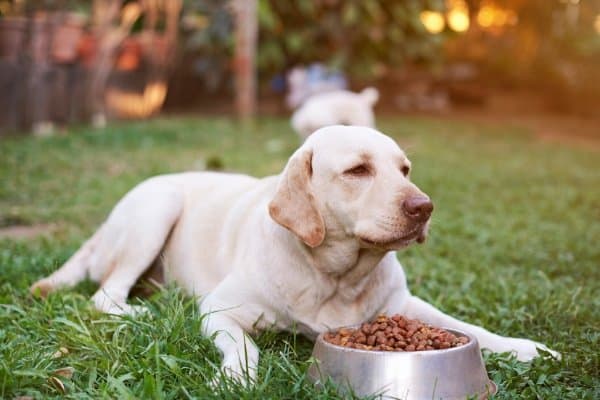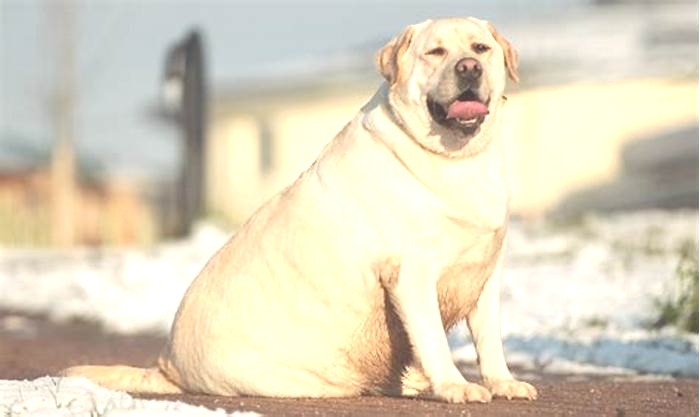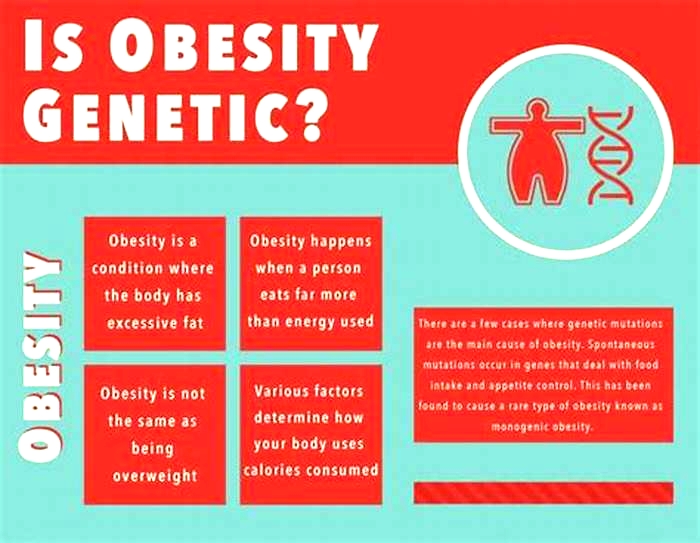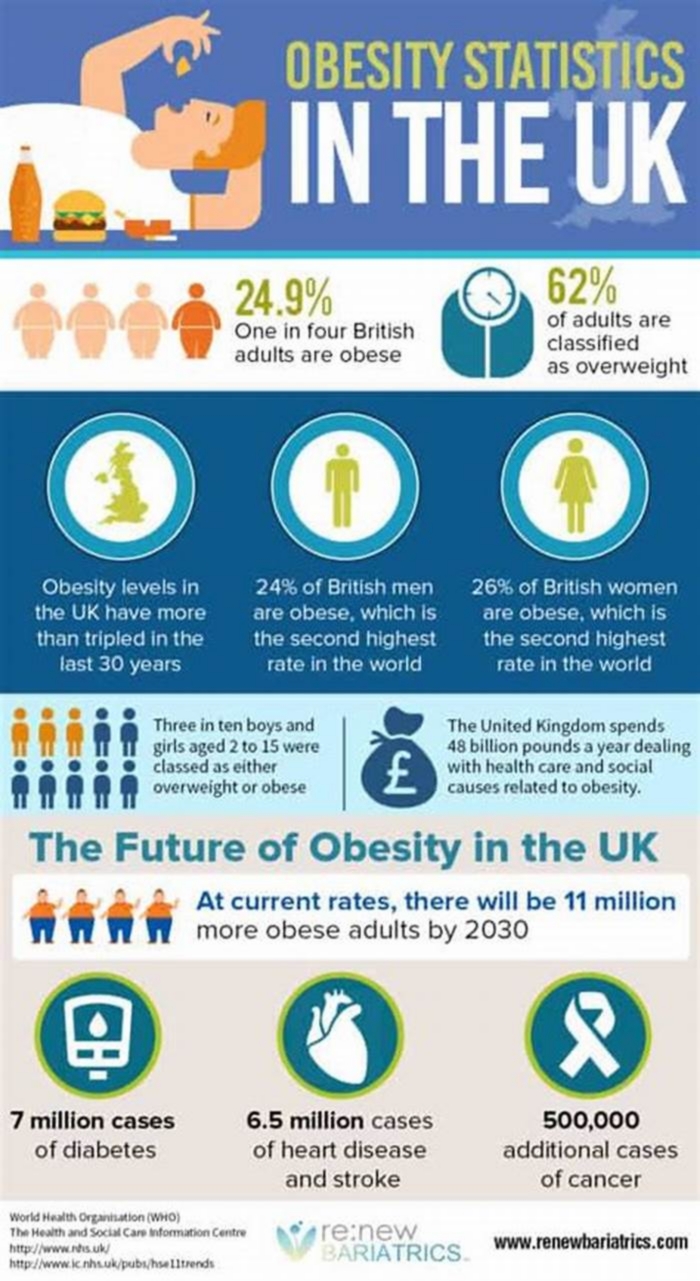Why are Labradors prone to obesity

Why Are Labradors Prone to Obesity? (2024)

According to a recent survey, a whopping 56% of American dogs are overweight or obese. That equates to approximately 50 million dogs with a weight issue.
Surprisingly, according to the same survey, only 15% of dog owners routinely weigh their pet every month, even when dealing with obesity issues. Perhaps even more shocking, by the age of 6 months, 21% of dogs are already overweight, setting themselves up for a lifelong battle against the bulge.
For nearly 30 years, Labrador Retrievers have topped the popularity charts, but theyre also one of the most likely breeds to struggle with their weight. Lets find out why.
Why are Labradors prone to obesity? In addition to lifestyle-related causes, a variant of a gene that regulates a feeling of fullness after a meal is found in approximately one-fourth of Labradors. This variant causes affected Labs to still feel hungry even after eating and is directly associated with obesity.
Obesity can have a devastating impact on your Labs health. Knowledge is power, right? So lets jump right in and take a closer look at this common Labrador issue.
Why Are So Many Labradors Overweight or Obese?
Gulping down entire meals without chewing and then begging for more, constantly scavenging for a free meal, being obsessed with food, and rummaging through the garbage for a tasty morsel. These are all very common Labrador behaviors.
If youve noticed that your Lab seems to be hungry all of the time and is becoming larger by the day, youre not alone. Most Labs are incredibly food motivated and can easily grow too heavy.
Generally, when a dog is 15% or more over the ideal weight for his breed and sex, he is considered overweight, but once he surpasses 30%, he is obese. Both of these conditions can occur when the amount of energy (in the form of food) consumed is greater than the amount of energy expended.
So why do Labs seem to struggle more with this issue than other breeds? Well, new-found scientific evidence suggests the answer might be genetic.
A gene called pro-opiomelanocortin (POMC), which has been found to be linked to appetite, weight, and satisfaction after eating, lacks 14 base pairs in about of all Labrador Retrievers (and Flat-Coated Retrievers too).
Scientists discovered that the more copies of this gene variant a dog has, the more likely the dog is to become overweight and obsessed with food. In fact, dogs with just one copy of this variant were on average 4 pounds heavier than normal.
This POMC variant compromises the dogs ability to feel full and satisfied after a meal, leaving him feeling hungry all of the time. This explains why so many Labradors are intensely food motivated (which does make training quite easy) and have a desire to eat that far exceeds their actual nutritional requirements leading to obesity.
Other Factors That Contribute to Labrador Obesity
Aside from genetic factors, Labs have several other factors working against them when it comes to maintaining an ideal weight.
Diet
Admittedly, its hard to say no to a Labs smiling face and imploring eyes when it comes to food, but overfeeding is one of the most prevalent contributors to fat Labs. In fact, just a few extra pieces of kibble every day can turn into several extra pounds of body fat over the course of a year.
Offering too large of meals isnt the only problem though, as feeding snacks, dog bones, and tidbits of people food throughout the day can quickly equate to added weight as well.
In addition to a lack of portion control, feeding the wrong kind of dog food can also lead to weight gain. Rich diets loaded with fat and excess calories or poor-quality kibble packed with empty calories can both enable your Lab to pack on extra pounds.
Sterilizing
When a dog is spayed or neutered, the consequent hormonal changes result in a slower metabolism and an increased appetite. If, after surgery, adjustments are not made to the dogs diet or exercise time, weight gain may occur easily, especially during the two years immediately following the procedure according to the National Center for Biotechnology Information.
Lifestyle
Another major contributor to Labrador weight gain is the fact that the vast majority of these active dogs are not routinely doing what they were bred to do. Remember, the Labrador was created to spend long hours working alongside Newfoundland fishermen in harsh conditions and frigid waters. Those working dogs had hearty appetites but quickly burned off extra calories each day through hard work.
Today, many Labs are not given the opportunity to exercise as they should. No long hours hunting and retrieving in the field, no days spent plunging into the water to bring back downed game. The result? Extra pounds accumulate.
Age
As dogs age, they tend to naturally slow down, just like people and will spend more and more time resting and sleeping as they ease into old age. Many owners find that this is the time when their once-trim Labrador becomes a little too hefty.
Health Conditions
Certain health issues, such as hypothyroidism or Cushings disease, can cause unexpected weight gain and lead to obesity if not properly treated. Before any weight-management program is started, a check-up by your veterinarian is recommended to rule out any underlying diseases or disorders.
How to Tell If Your Lab Is Overweight
Its a wise idea to evaluate your Labs weight once a month or so and it only takes a few moments to complete. Of course, you could bring him by your vets office to be weighed, but a visual check and quick feel of his bones can easily be done right at home.
View your Lab from directly overhead and from the side while he is standing up, and run your hands down his spine, over his ribcage, and across his rump, prodding gently with your fingertips for the rib, spine, and hip bones.
Signs of an overweight Labrador include:
- No noticeable indentation at the waist is present when viewed from above.
- Belly hangs down and there is no slight upward slant of the abdomen from the ribcage toward the hips.
- The rib and hip bones and the knobs of the backbone are difficult to find by gentle probing or cant be felt at all.
- Rolls of fat are present or dog appears bloated.
Dangers of Obesity
High blood pressure, joint issues, osteoarthritis, diabetes, kidney disease, respiratory troubles, heart disease, cancer, and a general decreased quality of life are all associated with obesity. Sound familiar? These same dangers plague people struggling with obesity as well.
How to Help Your Overweight Lab Lose Weight
An ounce of prevention is worth a pound of cure, but if your Lab is already on the pudgy side, you need to take action now.
The first step in reducing your Labs weight should be a trip to the vet to ensure that there arent any major health issues to deal with first. While there, ask your vet to calculate the correct amount of daily calories your dog should be eating so that you can make adjustments right away.
Also ask about replacing a portion of his regular meals with an equal amount of canned green beans to decrease calorie consumption or switching to a kibble formulated for weight management.

In place of his usual snacks, offer only healthy treats like a baby carrot, a few blueberries, or an apple slice, and practice tough love when he looks at you like hes starving.
Gradually increasing the amount of your Labs daily exercise is key to shedding extra weight. Dont just teach him to walk on a treadmill (although you can), but make each exercise session a fun bonding opportunity.
Dinnertime can also be used to increase physical activity if instead of placing his food in a bowl, you hide it within a snuffle mat or make a trail of kibble winding through your backyard.

These activities will get him moving, slow his eating down so his tummy has a chance to realize that its full and will provide mental stimulation.
Last update on 2024-04-26 at 03:24 / Affiliate links / Images from Amazon Product Advertising API
Why Are Labradors Prone to Cancer? (2024)

Cancer comes in many forms and can vary in severity and treatment options. This feared disease affects not only people, but animals as well, including our beloved dogs.
In fact, recent studies show that as many as one in four dogs will experience an uncontrolled, abnormal growth of cells (called neoplasia), which is often found to be malignant, during their lifetime.
And in dogs more than 10 years old, more than half will be affected by cancer.
Although Labradors are not nearly as prone to developing cancer as other breeds, such as Golden Retrievers, Rottweilers, Poodles, Cocker Spaniels, and Doberman Pinschers, are, they do have a slightly elevated risk.
Why Are Labrador Retrievers Prone to Developing Cancer? Due to risk factors such as genetic predisposition, lifestyle, environmental pollutants, poor breeding practices, and a tendency to become obese, Labs have slightly elevated odds of developing cancer compared to other breeds.
Of course, no one likes to think about cancer, but with statistics being what they are, its important to focus on the health of your Lab. Knowing the most common risk factors and eliminating as many as possible from your dogs life can effectively improve his odds of never having to face a grim diagnosis.
Why Do Labrador Retrievers Sometimes Get Cancer?
When it comes to cancer, there really are no easy answers. Many times, the exact reason a dog develops cancer is never known. However, scientists have identified certain factors that can increase the odds of future cancer development.
Youll notice that many of the following factors pertain to people as well. This is no coincidence. Cancer does not discriminate and the causes believed to trigger its development in people negatively affect our pets as well.
Genetics
Scientific studies indicate that genetics often contribute to a dogs chances of one day battling cancer. The findings are sufficient enough to conclude that a Lab with at least one parent who developed cancer during their lifetime has a greater risk of developing the dreaded disease himself at some point in his life.
Recent research by the Animal Health Trust, a veterinary research charity, discovered that as many as 70% of Labrador Retrievers show a distinct genetic risk factor, identified by a change in their DNA, that increases their odds of developing mast cell tumors, the most common canine skin cancer.
Studies further revealed that Labs with two copies of this risk factor are up to four times more likely to form mast cell tumors during their lifetime.
Lifestyle/Environment
Labrador Retrievers love people. Whether playing, working, or just hanging out, a Lab is happiest when alongside his owner and family. Unfortunately, being in such close proximity to people means that Labs are routinely exposed to the same toxins, carcinogens, and pollutants that we are, every day.
The same chemicals that lead to increased cancer rates in the human population can have devastating effects on Labs as well.
Consider for a moment how many toxins a Lab has contact with on a regular basis.
- Pesticides and herbicides in your yard, the park, neighbors yards, etc.
- Cleaning products, air fresheners, bleach, carpet cleaners, etc.
- Flea, tick, heartworm, and internal parasite medications.
- Carpet (surprised by this one? Carpets are commonly treated with dangerous chemicals before installation, contain harmful compounds in the adhesive backing, and continue to release toxins into your home.
- Second-hand cigarette smoke.
- Exhaust and pollution from cars, buses, large machinery, factories, etc.
These are, sadly, only some of the hazards Labs face every day. But remember that Labs often have their nose to the ground as they explore their world and thus receive more direct contact with harmful products.
The problem is further compounded by the topical products we apply directly to their body and the fact that dogs spend so much of their time lying on carpets, treated lawns, etc., all potentially harmful and toxic.
Diet
The diet of the typical modern-day dog is a far cry from that of their ancestors. In the wild, a dogs natural diet would consist mainly of meat and occasionally fruits, vegetables, and plants such as herbs.
In contrast, the majority of commercial dog food today contains questionable ingredients and nutrient-lacking fillers, with corn and wheat products usually within the top five ingredients. When was the last time you saw your dog grazing in a corn or wheat field?
Never, right?
Many oncologists believe that theres a definite link between sugar and cancer, as cancer needs sugar to survive and grow (cancer cells use an estimated 200 times more glucose than normal, healthy cells).
So, why are corn and wheat products potentially harmful? During digestion, carbohydrates such as corn and wheat are converted into blood sugar (glucose) and insulin levels rise. Excess glucose and high insulin levels are ideal conditions for cancer cells to take root.
In addition to questionable commercial kibble ingredients, Labs who are fed people food occasionally are subjected to the same harmful substances like preservatives, additives, dyes, pesticides, fertilizers, etc. that negatively affect our health.
Indiscriminate, Irresponsible Breeding
When Labs began climbing the popularity charts, breeders began springing up everywhere. Unfortunately, not every breeder had the breeds best interest at heart and this is sadly still the case today.
In an effort to produce as many puppies as possible, things like health testing, correct conformation, and breeding for strong, healthy immune systems was, and is, often neglected.
The result of such poor breeding practices has a direct effect on the overall health of the breed. Due to the disregard of health guidelines and protocols, many Labs were, and are, bred who carry a predisposition to developing cancer.
This, of course, doesnt bode well for the future health of the resulting puppies nor for the breed as a whole.
Obesity
Labs have a tendency to gain weight easily and become obese. Learn more about this problemin our article on Lab obesity. Being excessively overweight increases a Labs risk for developing cancer because fat cells produce adipokines (inflammatory proteins) which damage DNA and can lead to tumors.
What Types of Cancer Affect Labs?
The most commonly seen cancers in Labradors include lymphoma, mast cell tumors, melanoma, osteosarcoma, and hemangiosarcoma. The good news is that approximately half of all diagnosed canine cancers are treatable.
Warning Signs
Making sure your Lab receives routine veterinary check-ups is the best way to monitor his health and catch problems early on, but knowing the common warning signs and symptoms of canine cancers is important too. The most common symptoms include:
- Swellings, tumors, lumps, or discolored skin.
- Lethargy.
- Changes in behavior, appetite, and/or bathroom habits.
- Swollen lymph nodes.
- Abnormal bleeding.
- Wounds that wont heal.
- Sudden lameness.
- Difficulty breathing and/or eating.
- Sudden weight loss.
How is Cancer in Dogs Diagnosed?
A good veterinarian will perform a thorough physical exam, review the dogs medical history, and listen to your description of your dogs symptoms. If cancer is suspected, blood and urine tests may be performed; X-rays, ultrasounds, CT scans, or MRIs may be needed; and cytology or biopsy may be necessary.
Ways to Decrease Your Labs Odds of Developing Cancer
While there are no guarantees, there are steps you can take to lower your Labs chances of developing cancer.
- Switch to a natural, grain-free dog food, or work under the supervision of your vet to transition to a raw or home-prepared diet.
- Stop using harmful chemicals on your lawn and speak with your pest control service about safer options.
- Switch to natural indoor cleaning products.
- Limit exposure to carpets as much as possible. Providing him with his own bed may help.
- Carefully wash all fruits and vegetables with an all-natural cleansing wash before feeding them to your dog.
- Test your homes air quality , and if pollutants are found, upgrade your homes air filter.
- Have your Lab spayed or neutered to diminish the risk of mammary cancer and eliminate the chance of testicular cancer.
- Be sure your dog receives plenty of antioxidants in his diet to keep his immune system in peak health.
- Carefully manage your Labs weight and ensure that he gets plenty of exercise to stay in top shape.









